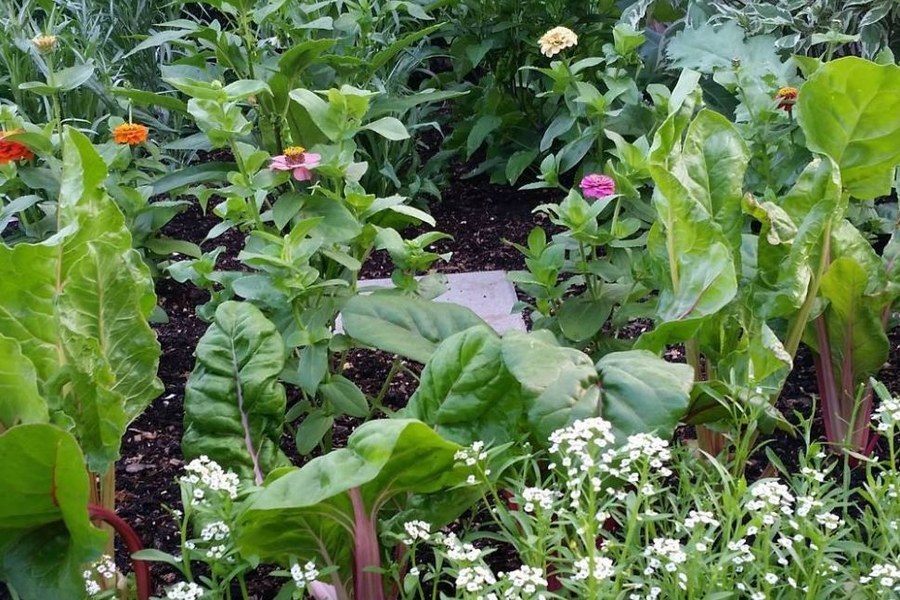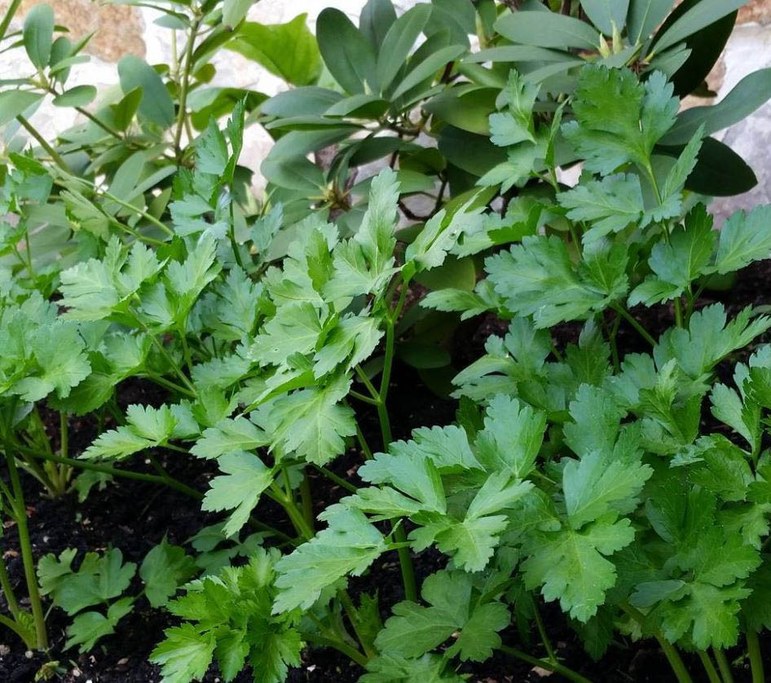Posted: April 2, 2021
Some people may be concerned that planting vegetables in a front yard garden bed may look messy or unattractive. Master Gardener Kristi Wenrich offers advice on how to incorporate edible plants into ornamental beds.

This front yard foundation garden bed in Lower Merion Township, Montgomery County contains over 30 Swiss chard, pepper, eggplant, and herb plants along with flowers.
When the pandemic worries started in 2020, many of my friends and neighbors developed a new interest in having a vegetable garden. Vegetable gardens can alleviate food insecurity, economic insecurity, or even just provide a "stay at home" hobby. As an avid gardener who shares a lot of photographs and information about my gardens on social media, I get asked a lot of questions about gardening in general. The question I was asked the most last year was, "How do I start a vegetable garden right now?" If you've never gardened before, don't have a lot of tools for digging or building raised beds and you don't have a lot of money to buy those tools or hire help to do the work for you, the most time-efficient and economical answer is to grow some vegetables and herbs in any existing garden beds you have on your property.
Many urban and suburban homes in Montgomery County already have at least one planting bed around the foundation of the home, along a path to a front door, near the driveway, or around a deck or patio. You don't need a large planting bed to grow food; it's easy to be successful in any sunny location. The startup costs are minimal; the only items required are a hand trowel for digging planting holes and some plants.
Some people may be concerned that planting vegetables in a front yard garden bed may look messy or unattractive. Rental homes with guidelines set by the landlord or homes in HOA communities with rules about the look of a home's landscape are common in Montgomery County. Plant selection and plant placement are key factors in determining the overall look of your garden bed. Plants with a smaller growth habit are easier to keep tidy than plants with long vines or tall stems. Choose tomato and cucumber plants labeled with terms like "patio, dwarf, micro, container, or bush." Look for information on the plant label that indicates the height and spread of your plants when selecting them at the nursery. Plan on placing plants that grow taller toward the back of a garden bed, and plants with a shorter height toward the front. Eggplants, with their soft, attractive leaves make a lovely backdrop for colorful flowers. Peppers of all varieties please the eye with vibrant, ripe fruit, and dark green leaves. Swiss chard and kale have colorful stems and leaves. Herbs like sage and thyme are perennial in Montgomery County and can be beautiful, fragrant, additions to your flower beds and tasty additions to your meals. Place like plants in your garden beds together in drifts, groups, or rows, alternating groupings of flowers with vegetables, if you prefer to keep your front yard food growing camouflaged.

Parsley plants make an attractive under planting to rhododendron shrubs in Lower Merion Township, Montgomery County.
Growing food in an existing flower bed isn't a new or revolutionary concept. People have always tucked away some food plants here and there in their cottage-style gardens or in pots on the balcony. Victory gardens were popular during World War II. Rosalind Creasy published many popular books on the subject; The Complete Book of Edible Landscaping, published in 1982 was considered a pioneering work on the topic. Brie Larson's more recent book, The Foodscape Revolution, was published in 2017, and includes many ideas on how to incorporate edible plants into ornamental beds. The pandemic has given this idea a new resurgence in popularity. If you're looking to start a vegetable garden quickly and inexpensively, I encourage you to include some vegetables in your existing ornamental planting beds.
Penn State Extension Articles

